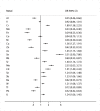Association between Concentrations of Metals in Urine and Adult Asthma: A Case-Control Study in Wuhan, China
- PMID: 27191859
- PMCID: PMC4871481
- DOI: 10.1371/journal.pone.0155818
Association between Concentrations of Metals in Urine and Adult Asthma: A Case-Control Study in Wuhan, China
Abstract
Background: Several metals have been reported to be associated with childhood asthma. However, the results on relationships between metals and risk of childhood asthma are inconclusive, and the research on adult asthma in the Chinese general population is rare.
Objectives: To investigate potential associations between levels of urinary metals and adult asthma.
Methods: A case-control study of 551 adult asthma cases and 551 gender- and age-matched controls was conducted in Wuhan, China. Demographic information was obtained, and lung function was assessed. The urinary concentrations of 22 metals were measured by inductively coupled plasma mass spectrometry.
Results: After adjusting for other metalsand other covariates, urinary cadmium, molybdenum, chromium, copper, uranium and selenium were positively associated with asthma, with odds ratios (95% CI) of 1.69 (1.00, 2.85), 3.76 (2.30, 6.16), 4.89 (3.04, 7.89), 6.06 (3.27, 11.21), 6.99 (4.37, 11.19) and 9.17 (4.16, 20.21), respectively. By contrast, urinary lead, barium, iron, zinc, nickel, manganese and rubidium were negatively associated with asthma, with odds ratios (95% CI) of 0.48 (0.29, 0.80), 0.44 (0.27, 0.71), 0.41 (0.26, 0.64), 0.40 (0.24, 0.66), 0.30 (0.22, 0.41), 0.23 (0.14, 0.39) and 0.07 (0.03, 0.15), respectively. When comparing urinary metals in different subgroups of cases with those in matched controls, the associations of above 13 metals with asthma prevalence were nearly the same.
Conclusions: Our results suggested that asthma prevalence in the Chinese adults was positively associated with urinary chromium, chromium, selenium, molybdenum, cadmium, and uranium, and negatively associated with urinary manganese, iron, nickel, zinc, rubidium, barium and lead. Additional research with larger populations in different regions is required to support our findings.
Conflict of interest statement
Figures



Similar articles
-
[Association between 23 urinary metals and mean platelet volume among a community-dwelling population in Wuhan, China].Zhonghua Yu Fang Yi Xue Za Zhi. 2016 Aug 6;50(8):689-97. doi: 10.3760/cma.j.issn.0253-9624.2016.08.005. Zhonghua Yu Fang Yi Xue Za Zhi. 2016. PMID: 27539521 Chinese.
-
[Association between personal exposure to metals in fine particulate matter and urinary metals: baseline results from a panel study].Zhonghua Yu Fang Yi Xue Za Zhi. 2016 Aug 6;50(8):673-9. doi: 10.3760/cma.j.issn.0253-9624.2016.08.003. Zhonghua Yu Fang Yi Xue Za Zhi. 2016. PMID: 27539519 Chinese.
-
[Association of urinary metals and lung function in general Chinese population of Wuhan].Zhonghua Yu Fang Yi Xue Za Zhi. 2016 Aug 6;50(8):680-8. doi: 10.3760/cma.j.issn.0253-9624.2016.08.004. Zhonghua Yu Fang Yi Xue Za Zhi. 2016. PMID: 27539520 Chinese.
-
Heavy metals exposure, lipid peroxidation and heart rate variability alteration: Association and mediation analyses in urban adults.Ecotoxicol Environ Saf. 2020 Dec 1;205:111149. doi: 10.1016/j.ecoenv.2020.111149. Epub 2020 Aug 20. Ecotoxicol Environ Saf. 2020. PMID: 32829210
-
The dose-response association of urinary metals with altered pulmonary function and risks of restrictive and obstructive lung diseases: a population-based study in China.BMJ Open. 2015 May 21;5(5):e007643. doi: 10.1136/bmjopen-2015-007643. BMJ Open. 2015. PMID: 25998037 Free PMC article.
Cited by
-
The impact of environmental pollution on the quality of mother's milk.Environ Sci Pollut Res Int. 2019 Mar;26(8):7405-7427. doi: 10.1007/s11356-019-04141-1. Epub 2019 Jan 28. Environ Sci Pollut Res Int. 2019. PMID: 30687894 Free PMC article.
-
Chronic low-level cadmium exposure in rats affects cytokine production by activated T cells.Toxicol Res (Camb). 2019 Jan 4;8(2):227-237. doi: 10.1039/c8tx00194d. eCollection 2019 Mar 1. Toxicol Res (Camb). 2019. PMID: 30997022 Free PMC article.
-
The effect of consuming bread contaminated with heavy metals on cardiovascular disease and calculating its risk assessment.Sci Rep. 2025 Jan 21;15(1):2710. doi: 10.1038/s41598-025-86240-3. Sci Rep. 2025. PMID: 39837925 Free PMC article.
-
Association between Exposure to Selected Heavy Metals and Blood Eosinophil Counts in Asthmatic Adults: Results from NHANES 2011-2018.J Clin Med. 2023 Feb 15;12(4):1543. doi: 10.3390/jcm12041543. J Clin Med. 2023. PMID: 36836077 Free PMC article.
-
Relationship between serum iron and blood eosinophil counts in asthmatic adults: data from NHANES 2011-2018.Front Immunol. 2023 Sep 4;14:1201160. doi: 10.3389/fimmu.2023.1201160. eCollection 2023. Front Immunol. 2023. PMID: 37731511 Free PMC article.
References
-
- World Health Organization. Asthma 2013 [updated November 2013]. Available from: http://www.who.int/mediacentre/factsheets/fs307/en/.
-
- Su N, Lin J, Liu G, Chen P, Zhou X, Wan H, et al. An epidemiological survey of current asthma control status in China. Zhonghua Nei Ke Za Zhi. 2014;53(8):601–6. - PubMed
-
- Malo JL. Occupational rhinitis and asthma due to metal salts. Allergy. 2005;60(2):138–9. - PubMed
Publication types
MeSH terms
Substances
LinkOut - more resources
Full Text Sources
Other Literature Sources
Medical

